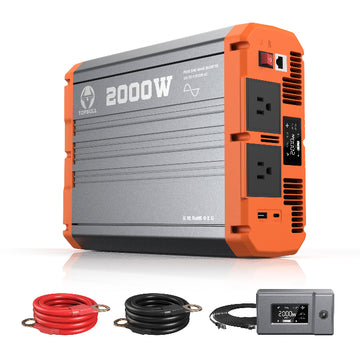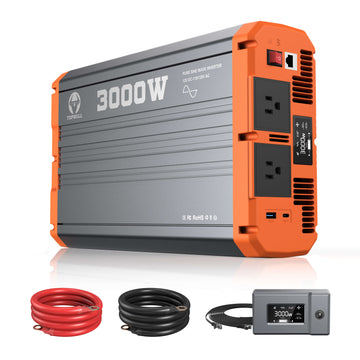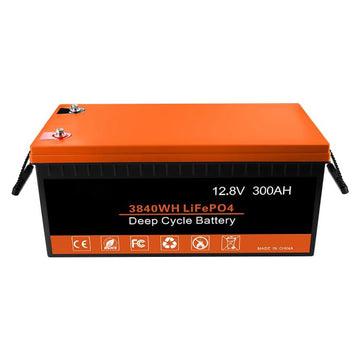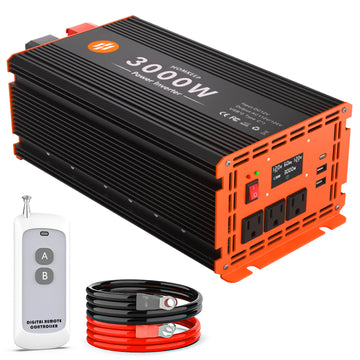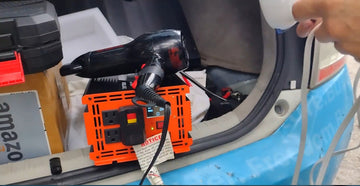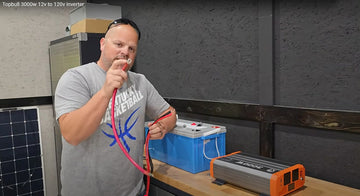From smartphones and laptops to drones and electric cars, batteries power almost every aspect of our daily lives. Lithium-ion and lithium-polymer batteries are the most popular choices due to their high energy efficiency and versatility.
However, choosing between these two types of batteries can be challenging. Many people wonder how they differ in performance and application. In this article, we'll take an in-depth look at the key differences, advantages, and disadvantages of lithium ion and lithium polymer batteries to help you decide which is better for your needs.
Content:
What is a lithium-ion battery?

Lithium-ion (Li-ion) batteries are rechargeable batteries that are widely used in modern electronics and energy storage solutions. Depending on the application, the batteries are usually packaged in cylindrical (18650, 21700) or prismatic shapes.
The cells that make up lithium-ion batteries contain lithium ions, which makes them different from other types of batteries. These ions are in motion, and they embed and de-embed back and forth between the two electrodes during charging and discharging. When a lithium-ion battery discharges, the lithium ions move from the negative electrode to the positive electrode. When a lithium ion battery is charged, the lithium ions move in the opposite direction.
Li-ion batteries have a liquid electrolyte inside to facilitate the movement of lithium ions between the anode and cathode during charge and discharge cycles.
Learn More: How Does a Lithium-ion Battery Work?
Lithium-ion battery common application
- Consumer electronics: Smartphones, laptops, tablets, cameras, and portable game consoles.
- Electric vehicles (EVs): Li-ion batteries power most electric vehicles due to their high energy density and rechargeability.
- Energy storage systems: Residential and commercial solar energy storage solutions .
- Power tools: Cordless drills, chainsaws and other tools that require high power.
- Medical devices: Devices such as pacemakers and portable medical equipment.
Pros and cons of lithium-ion batteries
Pros:
- High energy density
Compared with other rechargeable batteries, Li-ion batteries have a higher energy density (150-250 Wh/kg or 250-680 Wh/L), which can provide longer-lasting power for various devices.
- Low self-discharge rate
Li-ion batteries have a relatively low self-discharge rate, allowing them to hold their charge for long periods. The self-discharge rate of lithium-ion batteries is only 1-2% per month when not in use, much lower than nickel-metal hydride batteries (15-20%).
- Low maintenance
Lithium-ion batteries require little maintenance because they have no memory effect, so they don't need to be discharged regularly.
- Versatile applications
The versatility of lithium-ion batteries allows them to power a wide range of devices, from small consumer electronics such as smartphones to larger applications such as electric vehicles.
- Long life
Typically, lithium-ion batteries can withstand 500-1000 charge/discharge cycles before a significant capacity loss occurs.
Cons:
- High-temperature sensitivity
Exposure to high temperatures can significantly shorten the life of lithium-ion batteries.
- Safety Concerns
Overcharging or exposing Li-ion batteries to extreme conditions can lead to safety hazards, including expansion, overheating, or, in rare cases, combustion.
- Fixed shape design
Li-ion batteries are commonly shaped as cylindrical (18650, 21700) or prismatic and are not suitable for thin, lightweight or shaped devices.
What is a lithium polymer battery?

Lithium polymer batteries (often called Li-Po batteries) are similar to lithium-ion batteries but differ from lithium-ion batteries in several ways, including composition, performance, flexibility, cost, and safety.
Li-Po batteries use a gel or solid polymer matrix instead of a liquid electrolyte, eliminating the need for a porous diaphragm. This gives lithium polymer batteries greater flexibility and stability while allowing the use of flexible packaging materials. Lithium polymer batteries are also less prone to leakage, making them a safer choice.
Cosmetically, lithium polymer batteries are packaged in a lightweight, flexible pouch. The absence of a hard metal casing reduces weight while accommodating different shapes and sizes.
Lithium polymer batteries offer the potential for higher energy density and design flexibility, but they have a slightly higher self-discharge rate compared to conventional lithium-ion batteries.
Lithium polymer battery common application
Lithium polymer batteries are widely used in areas where weight and shape are important:
- Electronics: Smartphones, tablets, and smartwatches often use Li-Po batteries because of their thin, lightweight, and compact design.
- Drones and RC cars: Lithium polymer batteries are lightweight and have high discharge rates, making them ideal for drones, RC cars and helicopters.
- Wearable technology: Fitness trackers and other small devices can benefit from the flexible design of Li-Po batteries.
- Portable medical devices: Lithium polymer batteries can be used in lightweight, portable medical devices.
Pros and cons of lithium polymer batteries
Pros:
- Lightweight and flexible
Lithium Polymer batteries are significantly lighter, with the same 50Wh Li-Po battery weighing approximately 250 grams, which is 10-20% lighter than Li-Ion batteries. Ideal for weight-sensitive devices such as drones and smartwatches.
- Higher safety
Compared to liquid electrolytes, polymer electrolytes reduce the risk of leakage and fire, and there is less risk of thermal runaway, even in the event of overcharge or physical damage. Polymer electrolytes typically begin to decompose at 200-300°C, making them safer than lithium-ion batteries.
- Thinner design
The thin and light form factor of Li-Po batteries makes them suitable for ultra-thin devices. Many smartphones (e.g. iPhone 13) have batteries that are less than 4 millimeters thick.
- High discharge capacity
Li-Po batteries have discharge multipliers (C-rates) of 20C or higher, making them suitable for high instantaneous power demand scenarios.
Cons:
- Shorter lifespan
However, Li-Po batteries tend to have fewer charge/discharge cycles than Li-Ion batteries.
- Slightly higher self-discharge rate
Li-Po batteries tend to have a slightly higher self-discharge rate than Li-Ion batteries, resulting in a faster loss of stored energy when not in use.
- Susceptibility to physical damage
Due to their thin and flexible structure, Li-Po batteries are more susceptible to physical damage, which can affect their durability.
- Complex charging requirements
Because lithium-polymer batteries are sensitive to overcharging, they require a specialized charger to charge.
- Higher cost
Li-Po batteries are expensive, costing nearly twice as much as Li-Ion batteries.
Li-Ion vs. Li-Po battery: What are the differences?

Composition
One of the most significant differences between the two types of batteries is the material of the electrolyte. Lithium-ion batteries use a liquid/gel electrolyte between the anode and cathode, while lithium-polymer batteries use a polymer electrolyte (solid or gel).
Unlike Li-Ion batteries, Li-Po batteries do not have a porous diaphragm. This allows for greater flexibility in the shape of the battery. Lithium polymer batteries can also be made from flexible materials that can be adapted to any size or shape.
Battery energy density
Lithium-ion batteries typically have a higher energy density, which refers to the amount of energy stored per unit of weight. Because Li-Ion batteries are more powerful, they are more efficient than Li-Po batteries and can produce more power at one time.
However, because lithium polymer batteries are available in a variety of form factors, their flexible packaging contributes to the energy density potential.
Battery charging requirements
Charging lithium polymer batteries requires specialized chargers due to their sensitivity to overcharging and specific voltage parameters.
Lithium-ion batteries have a wider range of compatible chargers, providing more flexible charging options.
Charging speed
Li-Po batteries do not have the same energy density as Li-Ion batteries, but have faster charging capabilities and can handle high charging currents. In addition, they are able to handle lower self-discharge rates, which improves overall efficiency. Lithium polymer batteries are very effective when fast charging is required.
Battery safety and durability
Lithium-ion batteries have built-in protection circuitry that monitors temperature, current, and voltage to minimize overheating, excessive temperature rise, and over-discharge. The protection circuitry reduces the risk of thermal runaway and provides additional safety.
While both options are safe choices, lithium polymer batteries are considered safer due to their solid or gel-like electrolyte. This is because their gel-like electrolyte minimizes the risk of fire or leakage. Additionally, lithium polymer batteries have greater mechanical stability, which minimizes the possibility of puncture or damage.
Cost
When we talk about the price of Li-Po batteries versus Li-Ion batteries, Li-Po batteries are much more expensive than Li-Ion batteries. Lithium-ion batteries have been in commercial production for decades and therefore benefit from optimized manufacturing processes, advances in research, and high availability. Over the years, Li-Ion batteries have become cheaper to produce, which, combined with the high demand for lithium-ion batteries across a wide range of industries, has also led to increasingly favorable prices for Li-Ion batteries. Li-Ion batteries cost approximately $30 to $650 each, depending on the quality and voltage of the battery.
In contrast, Li-Po batteries are more expensive to produce due to the complexity of the manufacturing process. Li-Po batteries cost approximately $100 to $3,300 each. Therefore, lithium-ion batteries are more cost effective.
| Characteristics | Li-Ion Battery | Li-Po Battery |
| Energy density | Li-Po Battery | 100-200 Wh/kg |
| Cycle life | 500-1500 times | 300-500 times |
| Self-discharge rate | 1-2%/month | 2-5%/month |
| Thickness | ≥5mm | Can be as thin as 1-2mm |
| Safety lower | Lower, need to improve BMS | Higher, no explosion |
| Discharge rate | Usually 3-5C | Up to 20C or higher |
| Cost | Cheap | Almost twice the cost of Li-ion batteries |
| Nominal battery voltage | 3.2V | 3.7V |
Li-Ion vs. Li-Po battery: which to choose?
Lithium-ion and lithium-polymer batteries each have their own advantages in real-world applications. Determine your needs before choosing.
- If you need high energy density and long life, choose lithium-ion batteries.
- If you need light weight, flexibility and high safety, choose Lithium-Polymer batteries.
FAQ
Q: Does the iphone use a lithium-ion battery?
A: Yes, the iPhone battery is essentially a lithium-ion battery, but it is designed with a flexible aluminum-plastic film encapsulation that mimics the shape of a lithium-polymer battery.
Q: Can i bring lithium polymer batteries on a panel?
A: Yes, you can take Li-Po batteries on airplanes, but it depends on the capacity of the battery. There are important rules and guidelines that you must follow to ensure safety and compliance with airline and aviation regulations.
Q: Is Lipo or Li-ion battery safe?
A: Li-Po and li-ion batteries are generally safe when used and handled properly. Lithium polymer batteries have a better tolerance for physical damage. LiPo batteries are typically packaged in soft pouches rather than hard cases, which reduces the risk of rupture under pressure. In addition, the solid or gel-like polymer electrolyte reduces the risk of leakage compared to the liquid electrolyte in lithium-ion batteries.
Q: What is the lifespan of a lithium polymer battery?
A: The life of a LiPo battery depends on a number of factors, including usage patterns, charging habits, and environmental conditions. Under normal conditions, LiPo batteries typically last 300-500 full charge cycles.
Q: Which is better for drones, LiPo or Li-Ion batteries?
A: For most drones, lithium polymer batteries are usually preferred because of their small size, light weight and design flexibility. The shape and size can be customized to fit the space and weight requirements of the drone, making them suitable for lightweight requirements. At the same time, LiPo batteries support higher instantaneous discharge multipliers and can provide greater current output. This is important when the UAV is taking off, accelerating rapidly or performing high power tasks.
Q: Can I use lithium-ion batteries instead of lithium-polymer batteries?
A: You can use lithium-ion batteries instead of lithium-polymer batteries, but make sure the following conditions are met:
- The voltage and capacity match the device requirements
- The device does not have a high instantaneous power demand
- Ensure that the physical dimensions of the battery are appropriate and that it is properly secured
- Proper operating instructions are followed

